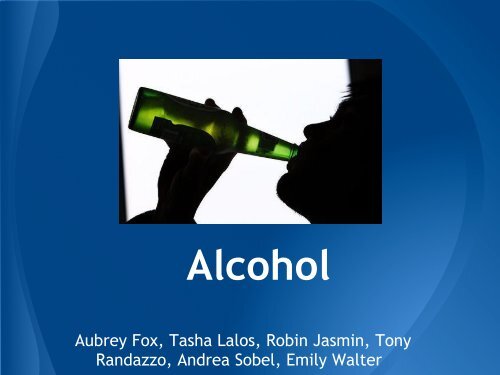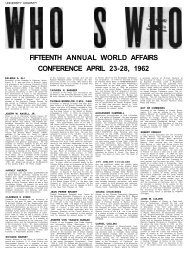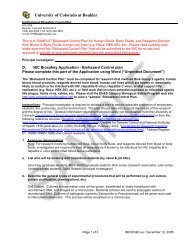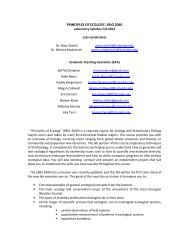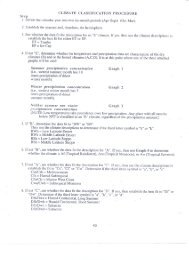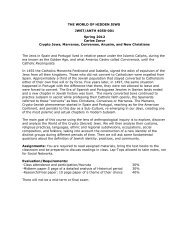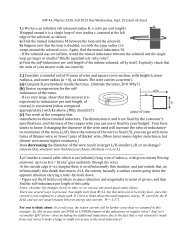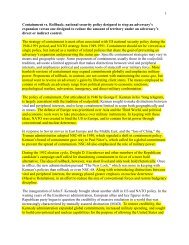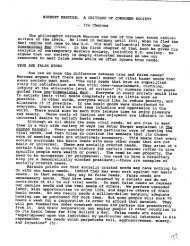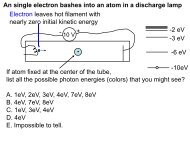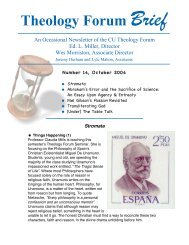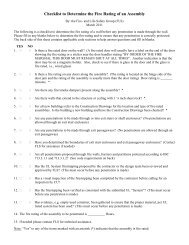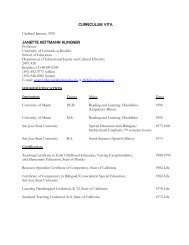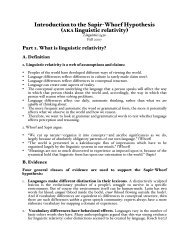Alcohol - University of Colorado Boulder
Alcohol - University of Colorado Boulder
Alcohol - University of Colorado Boulder
You also want an ePaper? Increase the reach of your titles
YUMPU automatically turns print PDFs into web optimized ePapers that Google loves.
<strong>Alcohol</strong><br />
Aubrey Fox, Tasha Lalos, Robin Jasmin, Tony<br />
Randazzo, Andrea Sobel, Emily Walter
History and Importance<br />
• Intentionally fermented beverages have<br />
been found in the Neolithic period<br />
(~10,000 B.C.)<br />
• 40 % <strong>of</strong> all college students report<br />
engaging in binge drinking<br />
• ~1,825 die from alcohol related injury<br />
• ~700,000 students are assaulted due to<br />
alcohol use
<strong>Alcohol</strong>ism
<strong>Alcohol</strong>ism<br />
• A chronic and progressive disease that<br />
includes:<br />
o Problems controlling your drinking<br />
o Being preoccupied with alcohol<br />
o Continuing to use alcohol even when it<br />
causes problems<br />
o Physical dependence<br />
o Withdrawal symptoms
• Neurochemical systems reinforce effect<br />
<strong>of</strong> alcohol:<br />
o GABA<br />
Neurochemical Systems<br />
o Opioid Peptide<br />
o Dopamine (DA)<br />
www.wikipedia.org/<br />
o Serotonin<br />
o Glutamate
Ethanol<br />
• Ethanol acts as a positive enforcer<br />
o increases firing in the ventral tegmental<br />
area (VTA)<br />
o elevates extracellular DA concentrations in<br />
the nucleus accumbens (NAc)<br />
• VTA and NAc both function in the reward<br />
pathway<br />
www.wikipedia.org/
Ferrer, E., M.A. Moral, and J. Bozzo. "Antiepileptic Drugs in <strong>Alcohol</strong>ism: An Update." Drugs <strong>of</strong> the Future 32.5 (2007): 429.<br />
Print.
Positive Reinforcement<br />
• A rewarding action that increases the<br />
probability <strong>of</strong> exhibiting a certain<br />
response.<br />
• The positive effects on the reward<br />
system lead to alcoholism<br />
o For example, dopamine and opioid release
Negative Reinforcement<br />
• A behavior is strengthened when<br />
stopping or avoiding a negative<br />
condition.<br />
o Ex: drinking to avoid anxiety/withdrawal<br />
symptoms<br />
• A critical component during the<br />
transition to dependence.<br />
o Increases drinking to avoid withdrawal
Inhibition <strong>of</strong> Dopamine Release<br />
• GABA normally inhibits dopamine release<br />
• <strong>Alcohol</strong> (ethanol) inhibits GABA, thus<br />
increasing dopamine release<br />
• DA release specifically in the Nucleus<br />
Accumbens leads directly to reward<br />
pathway
MOR<br />
• OPRM1 is a gene that encodes MOR<br />
o MOR is an opioid receptor<br />
• DA neurotransmission is modulated by<br />
MOR<br />
Heilig, Markus, David Goldman, Wade Berrettini, and Charles P. O'Brien. "Pharmacogenetic Approach to the Treatment <strong>of</strong> <strong>Alcohol</strong> Addiction." National Center for Biotechnology<br />
Information. U.S. National Library <strong>of</strong> Medicine, n.d. Web. 26 Oct. 2012.
Why is MOR Important?<br />
• A SNP on the OPRM1 gene at position<br />
118A --> 118G has been linked to alcohol<br />
reward<br />
o encodes an asparagine (N) --> aspartate (D)<br />
substitution<br />
www.wikipedia.org/
• 118G SNP<br />
OPRM1 and Mice<br />
o Mice with this SNP had a four fold increase<br />
<strong>of</strong> DA release compared to 118A mice<br />
• 118A to 118G increases alcohol induced<br />
dopamine release in the nucleus<br />
accumbens
MOR Experiment in Human<br />
Males<br />
Heilig, Markus, David Goldman, Wade Berrettini, and Charles P. O'Brien. "Pharmacogenetic Approach to the Treatment <strong>of</strong> <strong>Alcohol</strong> Addiction." National Center for Biotechnology<br />
Information. U.S. National Library <strong>of</strong> Medicine, n.d. Web. 26 Oct. 2012.
• Opioid receptor antagonist<br />
• A drug that aims to lessen alcohol<br />
cravings and reward outcomes.<br />
o Helps to "kick" addiction<br />
o Trade names:<br />
§� Revia<br />
§� Depade<br />
§� Vivitrol<br />
Naltrexone<br />
www.wikipedia.org/
Naltrexone Target<br />
• Naltrexone targets the OPRM1 gene<br />
o Naltrexone is more beneficial in treating<br />
alcoholism in those who carry the 118 G SNP<br />
o Patients who are homozygous for 118 A SNP<br />
are not affected
Naltrexone and Monkeys<br />
Heilig, Markus, David Goldman, Wade<br />
Berrettini, and Charles P. O'Brien.<br />
"Pharmacogenetic Approach to the<br />
Treatment <strong>of</strong> <strong>Alcohol</strong> Addiction." National<br />
Center for Biotechnology Information. U.S.<br />
National Library <strong>of</strong> Medicine, n.d. Web. 26<br />
Oct. 2012.<br />
118A<br />
118G
Clinical Observation<br />
• Some people improve dramatically while<br />
other addicts have no visible<br />
improvement<br />
o Found that family history and self reported<br />
cravings are important is predicting these<br />
outcomes
TOLERANCE<br />
Allostasis: stability through change<br />
http://pubs.niaaa.nih.gov/publications/arh314/298-309.htm
What is Tolerance?<br />
• General Overview<br />
• Different Types:<br />
o Behavioral Tolerance<br />
o Intrinsic Tolerance<br />
o Extrinsic Tolerance
Categories <strong>of</strong> Behavioral Tolerance<br />
• Acute Tolerance<br />
o Fastest Effects<br />
• Chronic Tolerance<br />
o Slowest Effects<br />
• Rapid Tolerance<br />
o In the Middle
Mechanisms<br />
• Post translational Modifications<br />
• Interactions with Membrane Lipids<br />
• Interaction with Auxiliary Proteins<br />
• Spatial Organization <strong>of</strong> Membrane<br />
Proteins.
BK Channel<br />
• K+ channel<br />
• Open longer due to alcohol<br />
• Transient<br />
o Closure=acute tolerance
Post-translational Modification<br />
• Proposed Mechanisms<br />
o Phosphorylation<br />
o Triggered by alcohol "directly"<br />
• Acute Tolerance
Changing Lipid Composition<br />
• Lipid Membrane Thickness<br />
o thickness= tolerance<br />
• Cholesterol levels<br />
o membrane cholesterol levels=<br />
tolerance<br />
o Differences between 1st and subsequent<br />
consumptions.<br />
o Chronic Tolerance
Cholesterol
Cholesterol...
Auxiliary Proteins<br />
• Subunit reorganization.<br />
• Subunits which can better endure alcohol<br />
• BK channel<br />
§� beta subunits 1 & 4<br />
o Chronic Tolerance<br />
§� Takes days.<br />
§� However, some have shown rapid onset.
GABAa<br />
• Enhanced function<br />
• Inhibitory
Spatial Organization<br />
• De-clusters BK channels<br />
o decreased sensitivity<br />
o Acute Tolerance
Genetics <strong>of</strong> Tolerance<br />
• Slo gene in Fruit Flies, Worms, Mice<br />
o Slo channel expression is significant<br />
o Different effects on different levels <strong>of</strong> tolerance<br />
Acute, Rapid, and Chronic<br />
• Hangover gene in Fruit Flies and Humans<br />
o <strong>Alcohol</strong> can manipulate the process <strong>of</strong> transcription <strong>of</strong><br />
genes involved in the creation <strong>of</strong> tolerance<br />
o SNPs <strong>of</strong> Hangover genes in humans were directly<br />
correlated to alcohol dependence<br />
o In conclusion, there are many different types <strong>of</strong> genes<br />
and pathways involved in the development <strong>of</strong> alcohol<br />
tolerance
Putting it all together<br />
• Acute, Rapid, Chronic Functional Categories<br />
o Underlying molecular borders are fuzzy<br />
• Central Nervous System Adapts to <strong>Alcohol</strong><br />
o Continual compensation from the body to<br />
different alcohol levels<br />
§� Stimulated simultaneously<br />
• Potential Therapeutic Targets for <strong>Alcohol</strong>ism<br />
o Membrane lipids, regulatory RNA molecules,<br />
channel protein subunits
Physical Effects <strong>of</strong><br />
<strong>Alcohol</strong> in the Brain
Effects on Specific Lobes<br />
• <strong>Alcohol</strong> affects the brain in a front to back manner<br />
• Frontal Lobe<br />
• Parietal Lobe<br />
• Temporal Lobe<br />
• Occipital Lobe<br />
• Cerebellum<br />
• Brain Stem
Brain Shrinkage?!<br />
• Neurodegeneration with prolonged<br />
alcohol use<br />
o Chronic exposure <strong>of</strong> alcohol results in<br />
pr<strong>of</strong>ound changes in:<br />
§� morphology<br />
§� growth<br />
§� survival <strong>of</strong> neurons.<br />
• <strong>Alcohol</strong>ics- substantial reduction in the<br />
volumes <strong>of</strong> the prefrontal cortex and<br />
cerebellum
Physical Brain changes<br />
• Prefrontal/Orbit<strong>of</strong>rontal cortices:<br />
o deficits = faulty motivational circuits<br />
leading to alcohol seeking behavior<br />
• <strong>Alcohol</strong> dependent humans have been<br />
found to have smaller amygdalae than<br />
non-dependent humans.<br />
http://pubs.niaaa.nih.gov/publications/arh313/185-195.htm
Row a) Control subject<br />
Row b) <strong>Alcohol</strong>ic subject<br />
http://drugtoxicology.wikispaces.com/Nervous+System+Damage
Decrease in Acetylcholine<br />
Systems<br />
• Slowed muscle use, lowered attention,<br />
lowered sensory perception<br />
o Pons Thalamus Cortex<br />
• Diminished effects in plasticity, learning<br />
and memory
Increase in GABA Levels<br />
• Slowed functions all throughout brain<br />
o GABA is the 'stop' neurotransmitter<br />
o Increases Dopamine
The Hangover<br />
The Not Fun Part
Hangover (not so) Fun Facts<br />
• <strong>Alcohol</strong> dehydrates you<br />
• Lowers your blood sugar<br />
• Disturbs your sleep and circadian rhythm
<strong>Alcohol</strong> Dehydrates You<br />
• Consumption increases urine production<br />
by inhibiting release <strong>of</strong> vasopressin in the<br />
pituitary gland<br />
o prevents kidneys from reabsorbing water<br />
• Sweating, vomiting, diarrhea also<br />
common with alcohol consumption<br />
o major dehydration
<strong>Alcohol</strong> Lowers Your Blood<br />
Sugar<br />
• Metabolism <strong>of</strong> alcohol leads to buildup <strong>of</strong><br />
Lactic Acid (the same thing that makes your<br />
muscles sore after a workout!)<br />
o Lactic Acid inhibits Glucose production<br />
o Less Glucose = less energy for the brain = more<br />
hangover symptoms<br />
• Diabetics are especially susceptible to<br />
hangovers for this reason<br />
• "Cure"?: Eat while drinking to balance out<br />
the glycemic levels in your body
<strong>Alcohol</strong> Disturbs Your Sleep<br />
• Disruption <strong>of</strong> normal circadian rhythm<br />
o Abnormal change in body temperatures<br />
o Disruption in hormone secretion that is<br />
normal in circadian rhythms<br />
§� Growth Hormones that help with wake cycles,<br />
bone growth and protein synthesis<br />
o Disruption <strong>of</strong> rise and fall <strong>of</strong> Cortisol levels,<br />
which are paired with metabolism and<br />
stress responses
Withdrawal Causes<br />
Compensation in the Body<br />
• In order to balance <strong>Alcohol</strong>'s sedative<br />
effects,<br />
o Decreased sensitivity <strong>of</strong> GABA receptors<br />
o Increased sensitivity <strong>of</strong> Glu receptors<br />
• After removal <strong>of</strong> alcohol, body remains<br />
in 'overdrive' for some time
Its Not Just <strong>Alcohol</strong><br />
That Causes Your<br />
Hangover
Congeners<br />
• Contribute to taste, smell, appearance<br />
• Evidence that alcohol with less congeners<br />
(more pure - gin/vodka) are less likely to<br />
produce hangover effects<br />
• <strong>Alcohol</strong> with more congeners (like whiskey,<br />
brandy, and red wine) are more likely to<br />
produce alcohol effects
• Is metabolized the<br />
same way as<br />
ethanol, but its<br />
metabolites are<br />
much more toxic:<br />
Formaldehyde and<br />
Formic Acid<br />
Methanol (CH4O)<br />
• Brandys and Whiskeys<br />
contain much more<br />
methanol
Work Cited<br />
Crowley JJ, Treistman SN, Dopico AM. Cholesterol antagonizes ethanol potentiation <strong>of</strong> human brain BKCa channels reconstituted<br />
i nto phospholipid bilayers. Mol Pharmacol. 2003: 64: 365-372.<br />
Ferrer, E., M.A. Moral, and J. Bozzo. "Antiepileptic Drugs in <strong>Alcohol</strong>ism: An Update." Drugs <strong>of</strong> the Future 32.5 (2007): 429.<br />
Print.<br />
Heilig, Markus, David Goldman, Wade Berrettini, and Charles P. O'Brien. "Pharmacogenetic Approach to the Treatment <strong>of</strong><br />
<strong>Alcohol</strong> Addiction." National Center for Biotechnology Information. U.S. National Library <strong>of</strong> Medicine, n.d. Web. 26 Oct.<br />
2012. http://www.ncbi.nlm.nih.gov/pubmed/22011682.<br />
Piertrzykowski, Andrzej, and Steven Treistman. "The Molecular Basis <strong>of</strong> Tolerance." <strong>University</strong> <strong>of</strong> Massachusetts, n.d. Web. 7<br />
March 2008. http://pubs.niaaa.nih.gov/publications/arh314/298-309.htm<br />
Weiss, Friedbert, and Linda J. Porrino. "The Journal <strong>of</strong> Neuroscience Society for Neuroscience." Behavioral Neurobiology <strong>of</strong><br />
<strong>Alcohol</strong> Addiction: Recent Advances and Challenges. The Journal <strong>of</strong> Neuroscience, n.d. Web. 26 Oct. 2012. http://<br />
www.jneurosci.org/content/22/9/3332.full.<br />
GABA. Digital image. Wikipedia. N.p., n.d. Web. http://en.wikipedia.org/wiki/GABA.<br />
Dopamine. Digital image. Wikipedia. N.p., n.d. Web. http://en.wikipedia.org/wiki/Dopamine.<br />
Serotonin. Digital image. Wikipedia. N.p., n.d. Web. http://en.wikipedia.org/wiki/Serotonin.<br />
Ethanol. Digital image. Wikipedia. N.p., n.d. Web. http://en.wikipedia.org/wiki/Ethanol.<br />
Asparagine. Digital image. Wikipedia. N.p., n.d. Web. http://en.wikipedia.org/wiki/Asparagine.<br />
Aspartate. Digital image. Wikipedia. N.p., n.d. Web. http://en.wikipedia.org/wiki/Aspartate.
•<br />
"<strong>Alcohol</strong><br />
• Yoshimoto,<br />
•<br />
Swift,<br />
• Boileau,<br />
Dekker,<br />
Works Cited<br />
and Health." <strong>Alcohol</strong> and Health. (2012): n. page. Web. 30 Oct. 2012. .<br />
K, W.J. McBride, L Lumeng, and T.K. Li. "<strong>Alcohol</strong>." <strong>Alcohol</strong>. 9.1 (1992): 17-22. Web. 30 Oct. 2012.<br />
Robert, and Dena Davidson. "<strong>Alcohol</strong> Health & Research World." <strong>Alcohol</strong> Health & Research World. 22.1<br />
(1998): 54-60. Web. 30 Oct. 2012. .<br />
Isabelle, Jean-Marc Assaad, et al. "Synapse."Synapse. 49.4 (2003): 226-231. Web. 30 Oct. 2012.<br />
Anothony. "What are the effects <strong>of</strong> alcohol on the brain? ." Scientific American. Scientific American, 26<br />
1999. Web. 30 Oct 2012. .
Interactive Question!<br />
What are some hangover myths that you<br />
can debunk from what you've learned<br />
today about hangovers and alcohol use?


